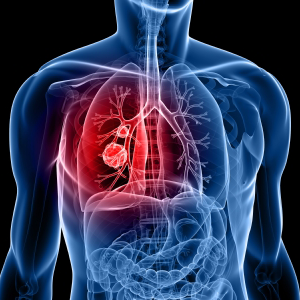Ivonescimab Combo Shows Meaningful PFS Improvement in EGFR-Mutant NSCLC
Ivonescimab plus chemotherapy reduced the risk of disease progression or death by 48% vs chemotherapy alone in patients with EGFR-mutant NSCLC.
Safety data revealed that no new safety signals were identified in the phase 3 study, with the safety profile of the combination noted to be manageable.

The addition of ivonescimab (SMT112) to chemotherapy demonstrated a statistically significant and clinically meaningful improvement in progression-free survival (PFS) outcomes vs chemotherapy alone in patients with EGFR-mutant locally advanced or metastatic non-squamous non–small cell lung cancer (NSCLC) following progression on prior EGFR tyrosine kinase inhibitor (TKI) therapy, according to a news release on findings from the phase 3 HARMONi trial (NCT06396065) from the drug’s developer, Summit Therapeutics.1
Results from the HARMONi trial evaluating ivonescimab plus chemotherapy vs chemotherapy alone in patients with EGFR-mutant NSCLC revealed that the trial successfully met its PFS primary end point while positively trending toward meeting its second primary end point of overall survival (OS).
At a prespecified primary data analysis, the combination showed a statistically significant PFS advantage, with an HR of 0.52 (95% CI, 0.41-0.66; P <.00001). Additionally, a clinically meaningful HR was observed among patients in both Asian and western areas, demonstrating a consistent PFS benefit between patients in both regions.
Furthermore, the ivonescimab group showed a positive OS trend with an HR of 0.79 (95% CI, 0.62-1.01; P = .057). Of note, the results of the primary analysis of the multiregional study were consistent with data from the single-region Chinese phase 3 HARMONi-A trial (NCT05184712), which showed an HR of 0.80 for OS at 52% data maturity.
“The evidence of a consistent benefit in PFS for both Asian and western patients, as well as the consistent OS results between the single-region HARMONi-A study and our global HARMONi study demonstrates the potential benefit ivonescimab has to bring to patients around the world, including the US,” Robert W. Duggan, chairman and co-chief executive officer of Summit Therapeutics, stated in the news release.1
Patients 18 to 75 years of age in the double-blind, multicenter phase 3 HARMONi trial were randomly assigned to receive ivonescimab plus pemetrexed and carboplatin or placebo plus pemetrexed and carboplatin.2 Those in the investigational arm were given ivonescimab plus pemetrexed and carboplatin intravenously every 3 weeks for up to 4 cycles, followed by maintenance ivonescimab and pemetrexed given every 3 weeks for a maximum of 2 years. Patients in the control arm received matching placebo plus pemetrexed and carboplatin for the same dosing schedule, as well as placebo plus pemetrexed for the same maintenance schedule.
The co-primary end points of the trial were OS and PFS. Secondary end points included objective response rate, incidence of adverse effects (AEs), duration of response, observed concentrations of ivonescimab, and incidence of anti-drug antibodies.
The developers plan to file a biologics license application (BLA) based on data from HARMONi but noted that the FDA necessitates a statistically significant OS benefit to support marketing authorization, which could impact the potential timing of a BLA filing. Investigators plan to present a more complete data presentation of the phase 3 HARMONi trial at a future medical conference.
Safety data revealed that no new safety signals were identified in the phase 3 study. Of note, grade 3 or higher treatment-emergent AEs (TEAEs) occurred in 56.9% of the investigational arm and 50.0% of the control arm. Additionally, fatal TEAEs were reported in 1.8% and 2.8% of the respective arms. The safety profile of the combination was noted to be manageable.
Patients were considered for trial inclusion if they had histologically or cytologically confirmed locally advanced or metastatic non-squamous NSCLC; EGFR activation mutations confirmed by tumor histology, cytology, or blood test prior to enrollment; and progression following prior receipt of EGFR TKIs. Additional inclusion criteria included an ECOG performance status of 0 or 1; an expected survival of at least 3 months; at least 1 measurable noncerebral lesion per RECIST v1.1 criteria; and adequate organ function.
References
- Ivonescimab plus chemotherapy Demonstrates statistically significant and clinically meaningful improvement in progression-free survival in patients with EGFR-mutant non-small cell lung cancer after EGFR TKI therapy in global study. News release. Summit Therapeutics. May 30, 2025. Accessed May 30, 2025. https://tinyurl.com/46ya5vdn
- Phase III study of AK112 for NSCLC patients. ClinicalTrials.gov. Updated October 8, 2024. Accessed May 30, 2025. https://tinyurl.com/3x3uneh4